Human Resource Management Report: H&M's HRM Strategies
VerifiedAdded on 2020/07/23
|13
|3960
|70
Report
AI Summary
This report provides a comprehensive analysis of Human Resource Management (HRM) practices within the context of H&M, a global retail company. It begins by defining the purpose and functions of HRM, highlighting key objectives such as recruitment, selection, training, and compensation. The report then explores the strengths and weaknesses of internal and external recruitment approaches, assessing their impact on talent acquisition and organizational dynamics. The second task delves into the benefits of HRM practices for both employers and employees, emphasizing the creation of healthy work environments, team building, and performance enhancement. Furthermore, it examines the effectiveness of HRM practices in relation to organizational productivity and profits, focusing on fair remuneration, flexible working conditions, performance evaluation, and talent management. The third task underscores the importance of employee relations, discussing strategies for fostering positive relationships between employers and employees to reduce conflicts and improve productivity. Key elements of employment legislation and their impact on HRM practices are also considered. Finally, the report concludes with an application of HRM practices within a work-related context, providing practical insights into how these strategies can be implemented to achieve organizational goals.
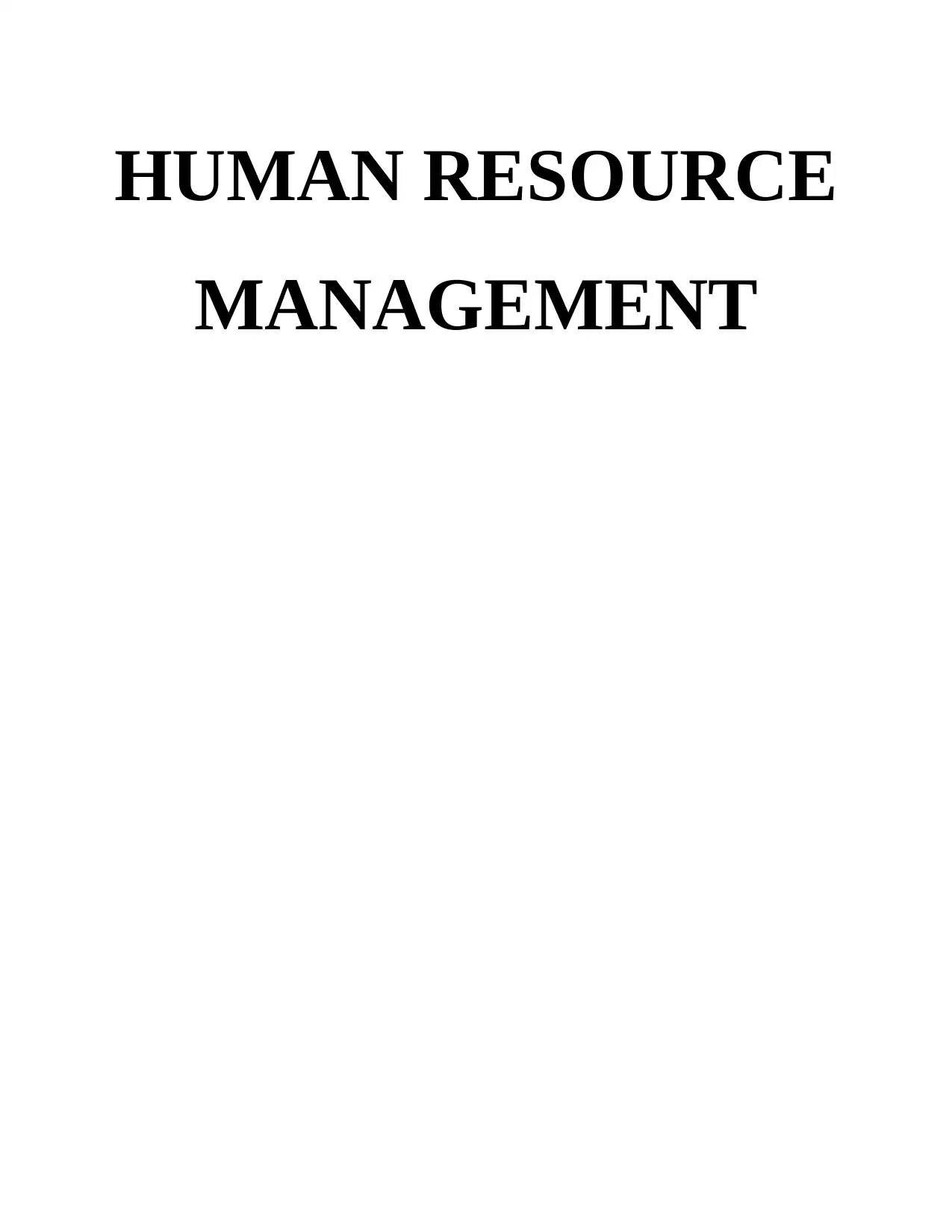
HUMAN RESOURCE
MANAGEMENT
MANAGEMENT
Paraphrase This Document
Need a fresh take? Get an instant paraphrase of this document with our AI Paraphraser
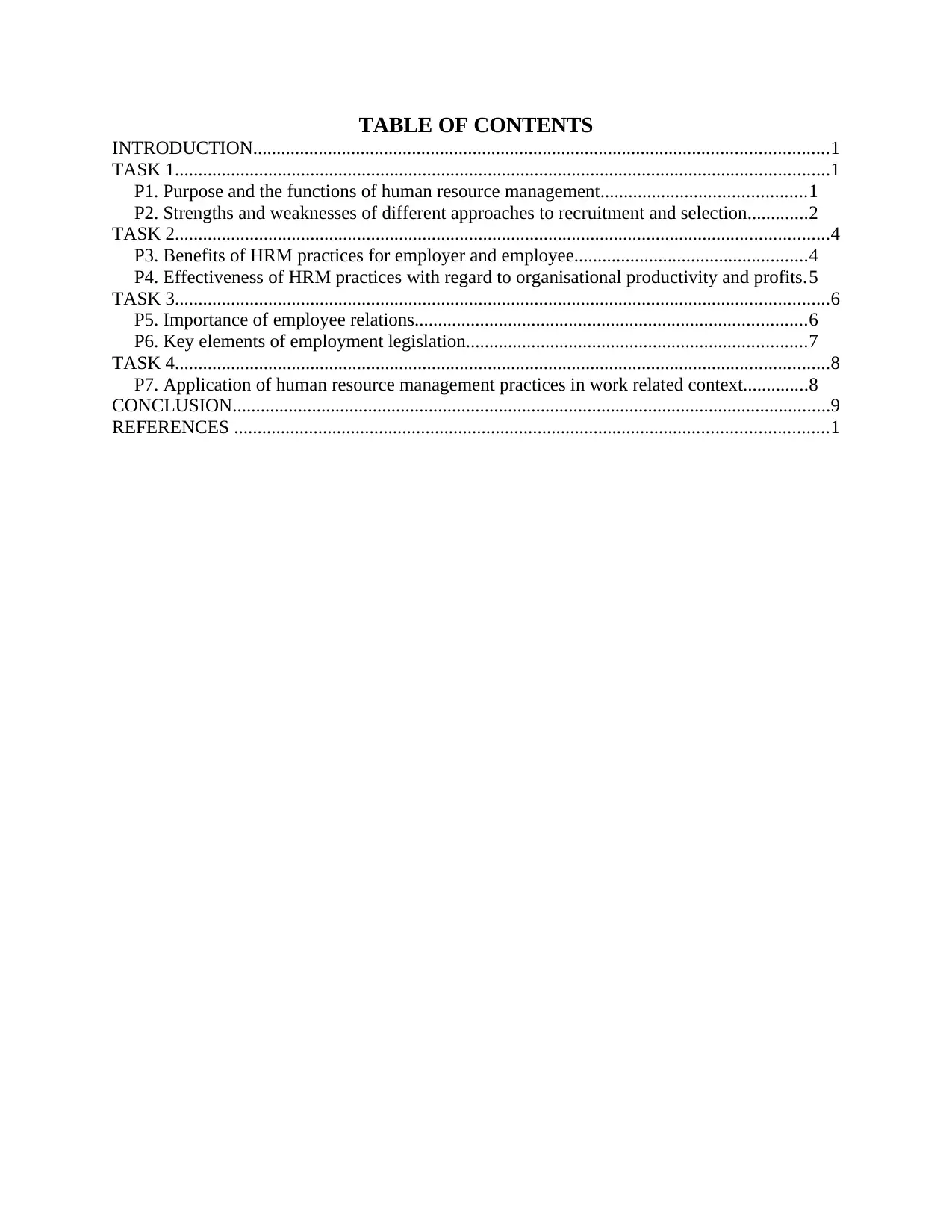
TABLE OF CONTENTS
INTRODUCTION...........................................................................................................................1
TASK 1............................................................................................................................................1
P1. Purpose and the functions of human resource management............................................1
P2. Strengths and weaknesses of different approaches to recruitment and selection.............2
TASK 2............................................................................................................................................4
P3. Benefits of HRM practices for employer and employee..................................................4
P4. Effectiveness of HRM practices with regard to organisational productivity and profits.5
TASK 3............................................................................................................................................6
P5. Importance of employee relations....................................................................................6
P6. Key elements of employment legislation.........................................................................7
TASK 4............................................................................................................................................8
P7. Application of human resource management practices in work related context..............8
CONCLUSION................................................................................................................................9
REFERENCES ...............................................................................................................................1
INTRODUCTION...........................................................................................................................1
TASK 1............................................................................................................................................1
P1. Purpose and the functions of human resource management............................................1
P2. Strengths and weaknesses of different approaches to recruitment and selection.............2
TASK 2............................................................................................................................................4
P3. Benefits of HRM practices for employer and employee..................................................4
P4. Effectiveness of HRM practices with regard to organisational productivity and profits.5
TASK 3............................................................................................................................................6
P5. Importance of employee relations....................................................................................6
P6. Key elements of employment legislation.........................................................................7
TASK 4............................................................................................................................................8
P7. Application of human resource management practices in work related context..............8
CONCLUSION................................................................................................................................9
REFERENCES ...............................................................................................................................1
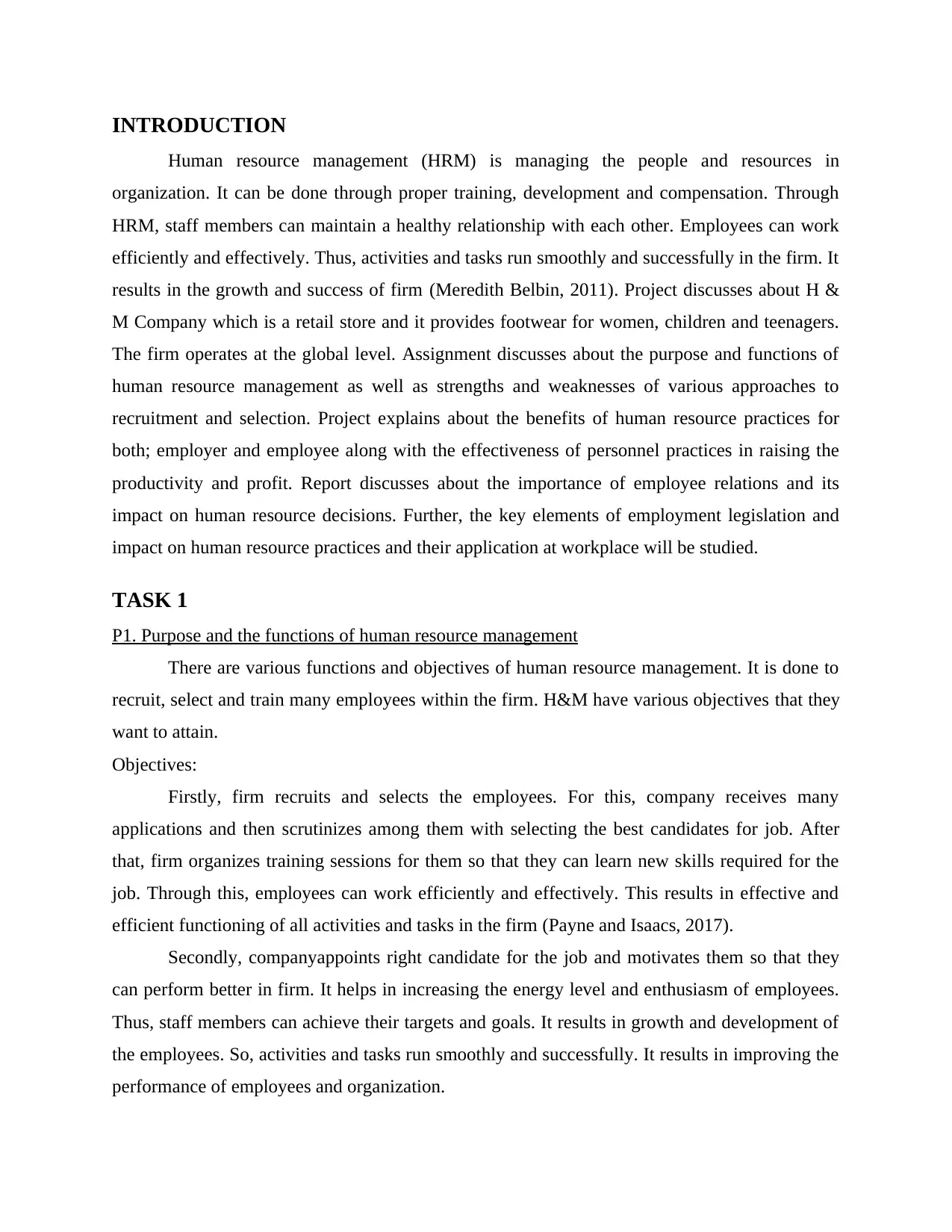
INTRODUCTION
Human resource management (HRM) is managing the people and resources in
organization. It can be done through proper training, development and compensation. Through
HRM, staff members can maintain a healthy relationship with each other. Employees can work
efficiently and effectively. Thus, activities and tasks run smoothly and successfully in the firm. It
results in the growth and success of firm (Meredith Belbin, 2011). Project discusses about H &
M Company which is a retail store and it provides footwear for women, children and teenagers.
The firm operates at the global level. Assignment discusses about the purpose and functions of
human resource management as well as strengths and weaknesses of various approaches to
recruitment and selection. Project explains about the benefits of human resource practices for
both; employer and employee along with the effectiveness of personnel practices in raising the
productivity and profit. Report discusses about the importance of employee relations and its
impact on human resource decisions. Further, the key elements of employment legislation and
impact on human resource practices and their application at workplace will be studied.
TASK 1
P1. Purpose and the functions of human resource management
There are various functions and objectives of human resource management. It is done to
recruit, select and train many employees within the firm. H&M have various objectives that they
want to attain.
Objectives:
Firstly, firm recruits and selects the employees. For this, company receives many
applications and then scrutinizes among them with selecting the best candidates for job. After
that, firm organizes training sessions for them so that they can learn new skills required for the
job. Through this, employees can work efficiently and effectively. This results in effective and
efficient functioning of all activities and tasks in the firm (Payne and Isaacs, 2017).
Secondly, companyappoints right candidate for the job and motivates them so that they
can perform better in firm. It helps in increasing the energy level and enthusiasm of employees.
Thus, staff members can achieve their targets and goals. It results in growth and development of
the employees. So, activities and tasks run smoothly and successfully. It results in improving the
performance of employees and organization.
Human resource management (HRM) is managing the people and resources in
organization. It can be done through proper training, development and compensation. Through
HRM, staff members can maintain a healthy relationship with each other. Employees can work
efficiently and effectively. Thus, activities and tasks run smoothly and successfully in the firm. It
results in the growth and success of firm (Meredith Belbin, 2011). Project discusses about H &
M Company which is a retail store and it provides footwear for women, children and teenagers.
The firm operates at the global level. Assignment discusses about the purpose and functions of
human resource management as well as strengths and weaknesses of various approaches to
recruitment and selection. Project explains about the benefits of human resource practices for
both; employer and employee along with the effectiveness of personnel practices in raising the
productivity and profit. Report discusses about the importance of employee relations and its
impact on human resource decisions. Further, the key elements of employment legislation and
impact on human resource practices and their application at workplace will be studied.
TASK 1
P1. Purpose and the functions of human resource management
There are various functions and objectives of human resource management. It is done to
recruit, select and train many employees within the firm. H&M have various objectives that they
want to attain.
Objectives:
Firstly, firm recruits and selects the employees. For this, company receives many
applications and then scrutinizes among them with selecting the best candidates for job. After
that, firm organizes training sessions for them so that they can learn new skills required for the
job. Through this, employees can work efficiently and effectively. This results in effective and
efficient functioning of all activities and tasks in the firm (Payne and Isaacs, 2017).
Secondly, companyappoints right candidate for the job and motivates them so that they
can perform better in firm. It helps in increasing the energy level and enthusiasm of employees.
Thus, staff members can achieve their targets and goals. It results in growth and development of
the employees. So, activities and tasks run smoothly and successfully. It results in improving the
performance of employees and organization.
⊘ This is a preview!⊘
Do you want full access?
Subscribe today to unlock all pages.

Trusted by 1+ million students worldwide
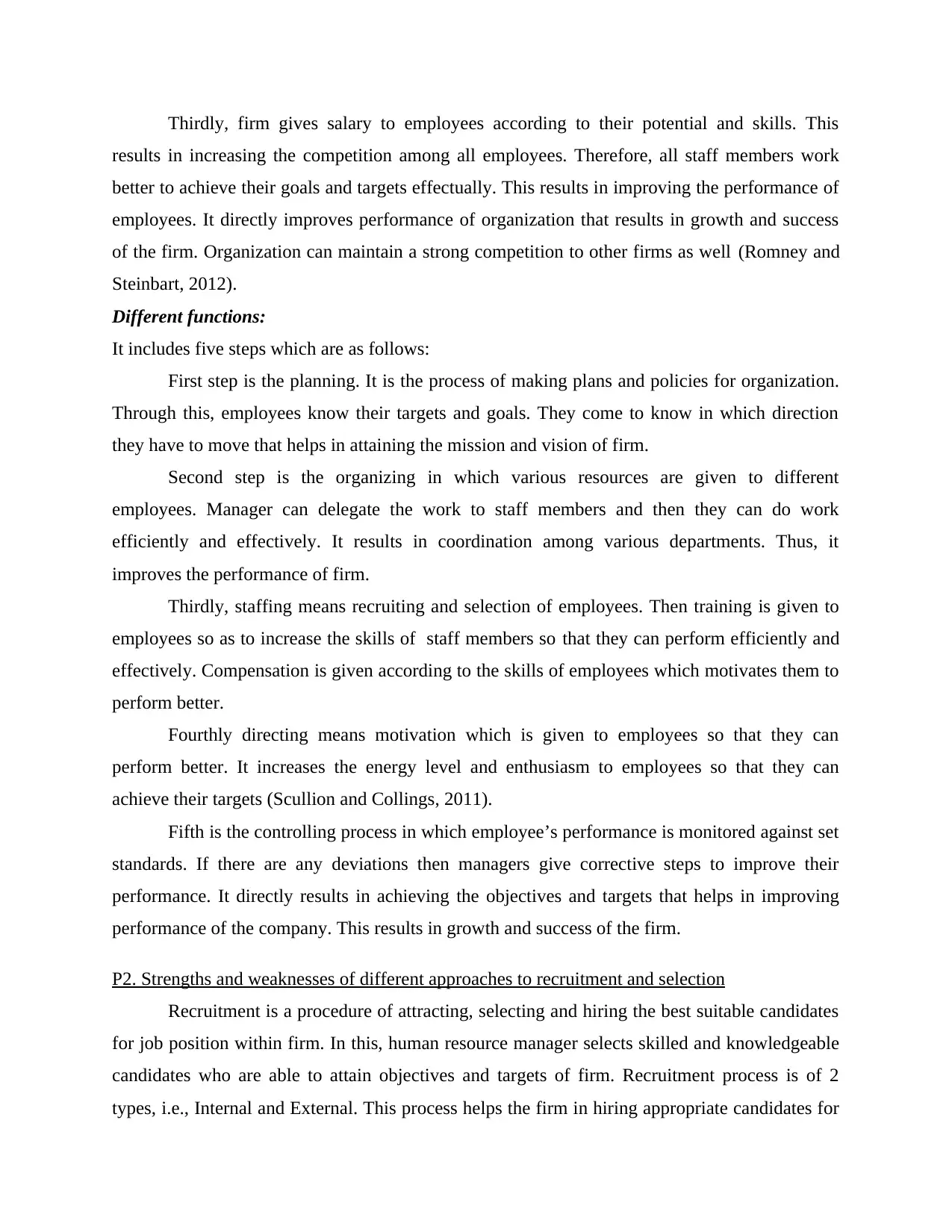
Thirdly, firm gives salary to employees according to their potential and skills. This
results in increasing the competition among all employees. Therefore, all staff members work
better to achieve their goals and targets effectually. This results in improving the performance of
employees. It directly improves performance of organization that results in growth and success
of the firm. Organization can maintain a strong competition to other firms as well (Romney and
Steinbart, 2012).
Different functions:
It includes five steps which are as follows:
First step is the planning. It is the process of making plans and policies for organization.
Through this, employees know their targets and goals. They come to know in which direction
they have to move that helps in attaining the mission and vision of firm.
Second step is the organizing in which various resources are given to different
employees. Manager can delegate the work to staff members and then they can do work
efficiently and effectively. It results in coordination among various departments. Thus, it
improves the performance of firm.
Thirdly, staffing means recruiting and selection of employees. Then training is given to
employees so as to increase the skills of staff members so that they can perform efficiently and
effectively. Compensation is given according to the skills of employees which motivates them to
perform better.
Fourthly directing means motivation which is given to employees so that they can
perform better. It increases the energy level and enthusiasm to employees so that they can
achieve their targets (Scullion and Collings, 2011).
Fifth is the controlling process in which employee’s performance is monitored against set
standards. If there are any deviations then managers give corrective steps to improve their
performance. It directly results in achieving the objectives and targets that helps in improving
performance of the company. This results in growth and success of the firm.
P2. Strengths and weaknesses of different approaches to recruitment and selection
Recruitment is a procedure of attracting, selecting and hiring the best suitable candidates
for job position within firm. In this, human resource manager selects skilled and knowledgeable
candidates who are able to attain objectives and targets of firm. Recruitment process is of 2
types, i.e., Internal and External. This process helps the firm in hiring appropriate candidates for
results in increasing the competition among all employees. Therefore, all staff members work
better to achieve their goals and targets effectually. This results in improving the performance of
employees. It directly improves performance of organization that results in growth and success
of the firm. Organization can maintain a strong competition to other firms as well (Romney and
Steinbart, 2012).
Different functions:
It includes five steps which are as follows:
First step is the planning. It is the process of making plans and policies for organization.
Through this, employees know their targets and goals. They come to know in which direction
they have to move that helps in attaining the mission and vision of firm.
Second step is the organizing in which various resources are given to different
employees. Manager can delegate the work to staff members and then they can do work
efficiently and effectively. It results in coordination among various departments. Thus, it
improves the performance of firm.
Thirdly, staffing means recruiting and selection of employees. Then training is given to
employees so as to increase the skills of staff members so that they can perform efficiently and
effectively. Compensation is given according to the skills of employees which motivates them to
perform better.
Fourthly directing means motivation which is given to employees so that they can
perform better. It increases the energy level and enthusiasm to employees so that they can
achieve their targets (Scullion and Collings, 2011).
Fifth is the controlling process in which employee’s performance is monitored against set
standards. If there are any deviations then managers give corrective steps to improve their
performance. It directly results in achieving the objectives and targets that helps in improving
performance of the company. This results in growth and success of the firm.
P2. Strengths and weaknesses of different approaches to recruitment and selection
Recruitment is a procedure of attracting, selecting and hiring the best suitable candidates
for job position within firm. In this, human resource manager selects skilled and knowledgeable
candidates who are able to attain objectives and targets of firm. Recruitment process is of 2
types, i.e., Internal and External. This process helps the firm in hiring appropriate candidates for
Paraphrase This Document
Need a fresh take? Get an instant paraphrase of this document with our AI Paraphraser
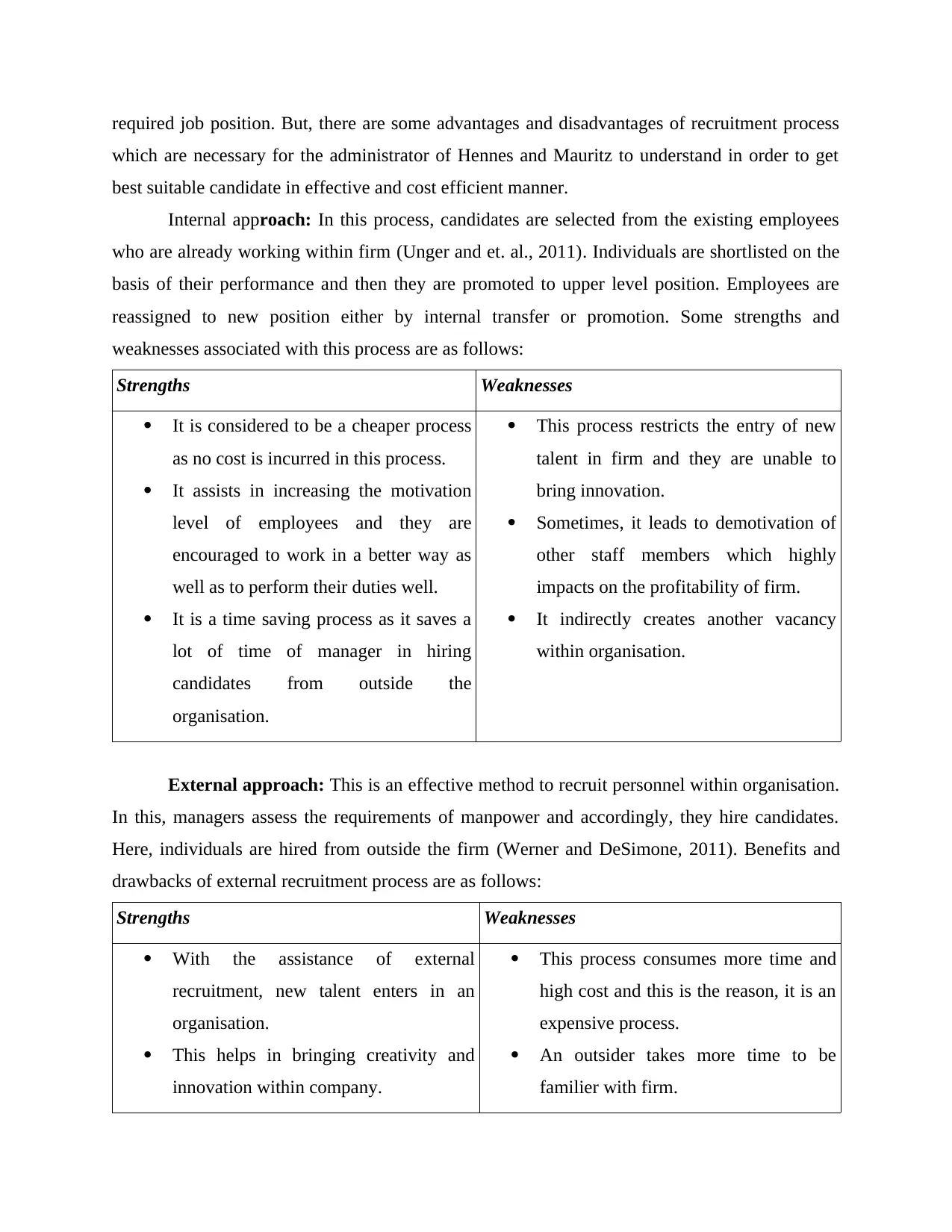
required job position. But, there are some advantages and disadvantages of recruitment process
which are necessary for the administrator of Hennes and Mauritz to understand in order to get
best suitable candidate in effective and cost efficient manner.
Internal approach: In this process, candidates are selected from the existing employees
who are already working within firm (Unger and et. al., 2011). Individuals are shortlisted on the
basis of their performance and then they are promoted to upper level position. Employees are
reassigned to new position either by internal transfer or promotion. Some strengths and
weaknesses associated with this process are as follows:
Strengths Weaknesses
It is considered to be a cheaper process
as no cost is incurred in this process.
It assists in increasing the motivation
level of employees and they are
encouraged to work in a better way as
well as to perform their duties well.
It is a time saving process as it saves a
lot of time of manager in hiring
candidates from outside the
organisation.
This process restricts the entry of new
talent in firm and they are unable to
bring innovation.
Sometimes, it leads to demotivation of
other staff members which highly
impacts on the profitability of firm.
It indirectly creates another vacancy
within organisation.
External approach: This is an effective method to recruit personnel within organisation.
In this, managers assess the requirements of manpower and accordingly, they hire candidates.
Here, individuals are hired from outside the firm (Werner and DeSimone, 2011). Benefits and
drawbacks of external recruitment process are as follows:
Strengths Weaknesses
With the assistance of external
recruitment, new talent enters in an
organisation.
This helps in bringing creativity and
innovation within company.
This process consumes more time and
high cost and this is the reason, it is an
expensive process.
An outsider takes more time to be
familier with firm.
which are necessary for the administrator of Hennes and Mauritz to understand in order to get
best suitable candidate in effective and cost efficient manner.
Internal approach: In this process, candidates are selected from the existing employees
who are already working within firm (Unger and et. al., 2011). Individuals are shortlisted on the
basis of their performance and then they are promoted to upper level position. Employees are
reassigned to new position either by internal transfer or promotion. Some strengths and
weaknesses associated with this process are as follows:
Strengths Weaknesses
It is considered to be a cheaper process
as no cost is incurred in this process.
It assists in increasing the motivation
level of employees and they are
encouraged to work in a better way as
well as to perform their duties well.
It is a time saving process as it saves a
lot of time of manager in hiring
candidates from outside the
organisation.
This process restricts the entry of new
talent in firm and they are unable to
bring innovation.
Sometimes, it leads to demotivation of
other staff members which highly
impacts on the profitability of firm.
It indirectly creates another vacancy
within organisation.
External approach: This is an effective method to recruit personnel within organisation.
In this, managers assess the requirements of manpower and accordingly, they hire candidates.
Here, individuals are hired from outside the firm (Werner and DeSimone, 2011). Benefits and
drawbacks of external recruitment process are as follows:
Strengths Weaknesses
With the assistance of external
recruitment, new talent enters in an
organisation.
This helps in bringing creativity and
innovation within company.
This process consumes more time and
high cost and this is the reason, it is an
expensive process.
An outsider takes more time to be
familier with firm.
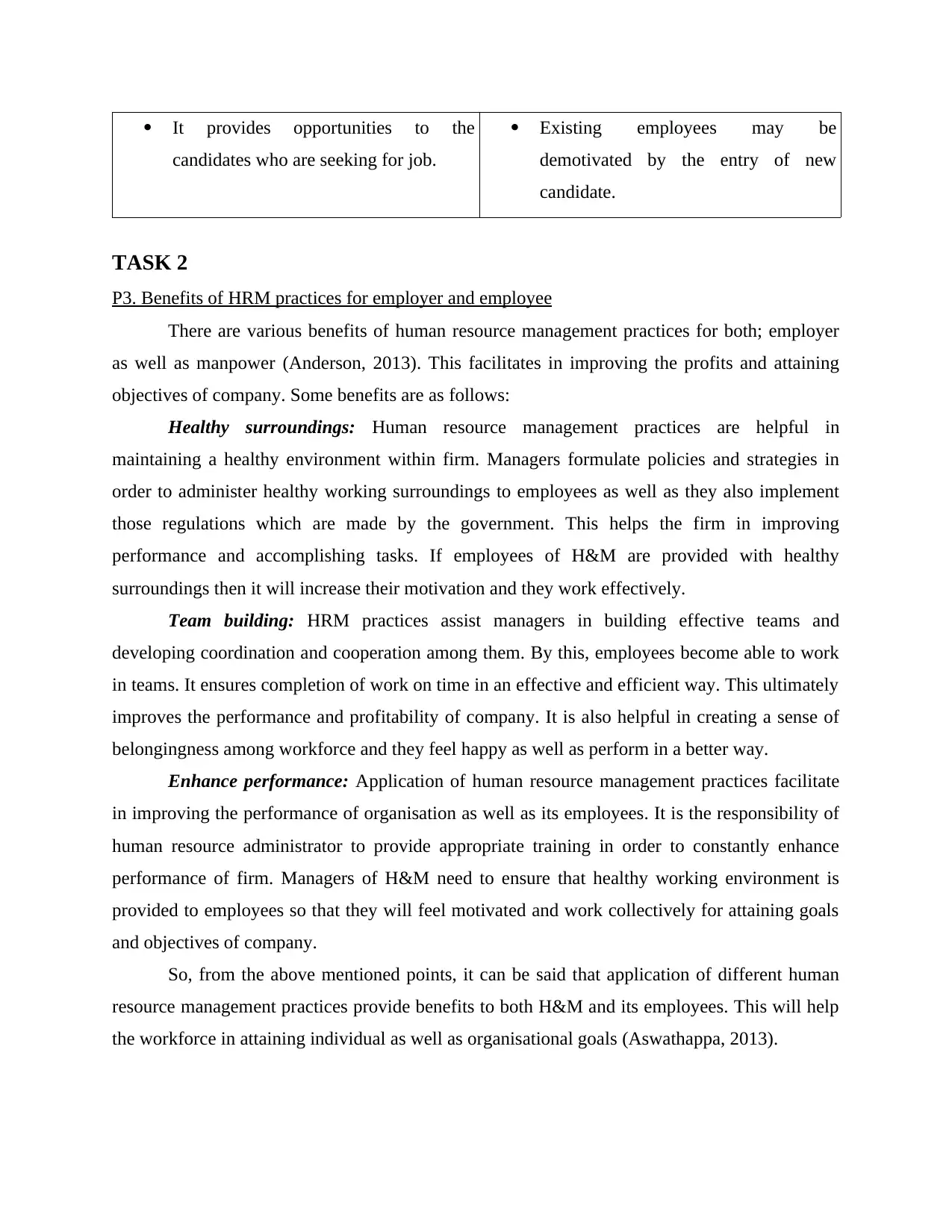
It provides opportunities to the
candidates who are seeking for job.
Existing employees may be
demotivated by the entry of new
candidate.
TASK 2
P3. Benefits of HRM practices for employer and employee
There are various benefits of human resource management practices for both; employer
as well as manpower (Anderson, 2013). This facilitates in improving the profits and attaining
objectives of company. Some benefits are as follows:
Healthy surroundings: Human resource management practices are helpful in
maintaining a healthy environment within firm. Managers formulate policies and strategies in
order to administer healthy working surroundings to employees as well as they also implement
those regulations which are made by the government. This helps the firm in improving
performance and accomplishing tasks. If employees of H&M are provided with healthy
surroundings then it will increase their motivation and they work effectively.
Team building: HRM practices assist managers in building effective teams and
developing coordination and cooperation among them. By this, employees become able to work
in teams. It ensures completion of work on time in an effective and efficient way. This ultimately
improves the performance and profitability of company. It is also helpful in creating a sense of
belongingness among workforce and they feel happy as well as perform in a better way.
Enhance performance: Application of human resource management practices facilitate
in improving the performance of organisation as well as its employees. It is the responsibility of
human resource administrator to provide appropriate training in order to constantly enhance
performance of firm. Managers of H&M need to ensure that healthy working environment is
provided to employees so that they will feel motivated and work collectively for attaining goals
and objectives of company.
So, from the above mentioned points, it can be said that application of different human
resource management practices provide benefits to both H&M and its employees. This will help
the workforce in attaining individual as well as organisational goals (Aswathappa, 2013).
candidates who are seeking for job.
Existing employees may be
demotivated by the entry of new
candidate.
TASK 2
P3. Benefits of HRM practices for employer and employee
There are various benefits of human resource management practices for both; employer
as well as manpower (Anderson, 2013). This facilitates in improving the profits and attaining
objectives of company. Some benefits are as follows:
Healthy surroundings: Human resource management practices are helpful in
maintaining a healthy environment within firm. Managers formulate policies and strategies in
order to administer healthy working surroundings to employees as well as they also implement
those regulations which are made by the government. This helps the firm in improving
performance and accomplishing tasks. If employees of H&M are provided with healthy
surroundings then it will increase their motivation and they work effectively.
Team building: HRM practices assist managers in building effective teams and
developing coordination and cooperation among them. By this, employees become able to work
in teams. It ensures completion of work on time in an effective and efficient way. This ultimately
improves the performance and profitability of company. It is also helpful in creating a sense of
belongingness among workforce and they feel happy as well as perform in a better way.
Enhance performance: Application of human resource management practices facilitate
in improving the performance of organisation as well as its employees. It is the responsibility of
human resource administrator to provide appropriate training in order to constantly enhance
performance of firm. Managers of H&M need to ensure that healthy working environment is
provided to employees so that they will feel motivated and work collectively for attaining goals
and objectives of company.
So, from the above mentioned points, it can be said that application of different human
resource management practices provide benefits to both H&M and its employees. This will help
the workforce in attaining individual as well as organisational goals (Aswathappa, 2013).
⊘ This is a preview!⊘
Do you want full access?
Subscribe today to unlock all pages.

Trusted by 1+ million students worldwide
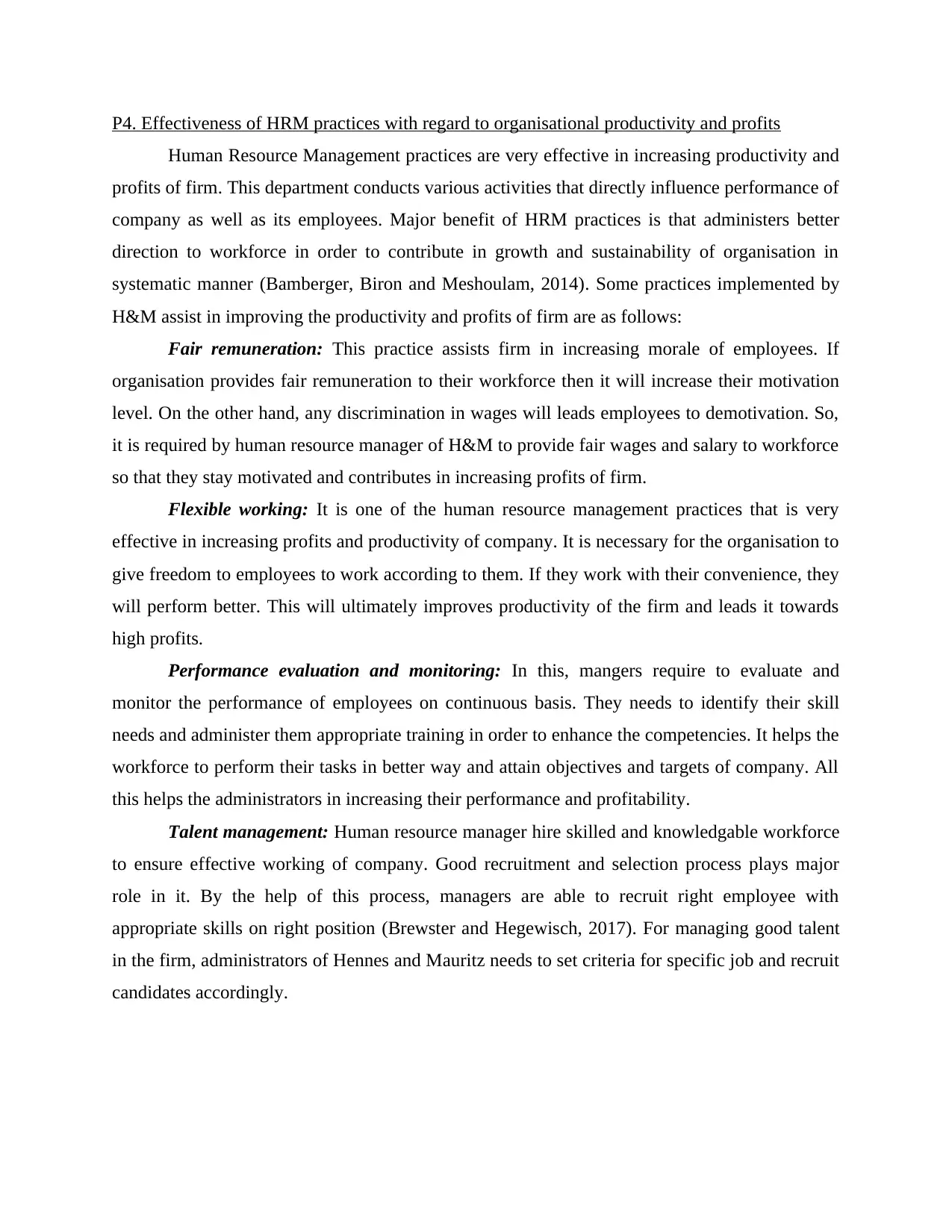
P4. Effectiveness of HRM practices with regard to organisational productivity and profits
Human Resource Management practices are very effective in increasing productivity and
profits of firm. This department conducts various activities that directly influence performance of
company as well as its employees. Major benefit of HRM practices is that administers better
direction to workforce in order to contribute in growth and sustainability of organisation in
systematic manner (Bamberger, Biron and Meshoulam, 2014). Some practices implemented by
H&M assist in improving the productivity and profits of firm are as follows:
Fair remuneration: This practice assists firm in increasing morale of employees. If
organisation provides fair remuneration to their workforce then it will increase their motivation
level. On the other hand, any discrimination in wages will leads employees to demotivation. So,
it is required by human resource manager of H&M to provide fair wages and salary to workforce
so that they stay motivated and contributes in increasing profits of firm.
Flexible working: It is one of the human resource management practices that is very
effective in increasing profits and productivity of company. It is necessary for the organisation to
give freedom to employees to work according to them. If they work with their convenience, they
will perform better. This will ultimately improves productivity of the firm and leads it towards
high profits.
Performance evaluation and monitoring: In this, mangers require to evaluate and
monitor the performance of employees on continuous basis. They needs to identify their skill
needs and administer them appropriate training in order to enhance the competencies. It helps the
workforce to perform their tasks in better way and attain objectives and targets of company. All
this helps the administrators in increasing their performance and profitability.
Talent management: Human resource manager hire skilled and knowledgable workforce
to ensure effective working of company. Good recruitment and selection process plays major
role in it. By the help of this process, managers are able to recruit right employee with
appropriate skills on right position (Brewster and Hegewisch, 2017). For managing good talent
in the firm, administrators of Hennes and Mauritz needs to set criteria for specific job and recruit
candidates accordingly.
Human Resource Management practices are very effective in increasing productivity and
profits of firm. This department conducts various activities that directly influence performance of
company as well as its employees. Major benefit of HRM practices is that administers better
direction to workforce in order to contribute in growth and sustainability of organisation in
systematic manner (Bamberger, Biron and Meshoulam, 2014). Some practices implemented by
H&M assist in improving the productivity and profits of firm are as follows:
Fair remuneration: This practice assists firm in increasing morale of employees. If
organisation provides fair remuneration to their workforce then it will increase their motivation
level. On the other hand, any discrimination in wages will leads employees to demotivation. So,
it is required by human resource manager of H&M to provide fair wages and salary to workforce
so that they stay motivated and contributes in increasing profits of firm.
Flexible working: It is one of the human resource management practices that is very
effective in increasing profits and productivity of company. It is necessary for the organisation to
give freedom to employees to work according to them. If they work with their convenience, they
will perform better. This will ultimately improves productivity of the firm and leads it towards
high profits.
Performance evaluation and monitoring: In this, mangers require to evaluate and
monitor the performance of employees on continuous basis. They needs to identify their skill
needs and administer them appropriate training in order to enhance the competencies. It helps the
workforce to perform their tasks in better way and attain objectives and targets of company. All
this helps the administrators in increasing their performance and profitability.
Talent management: Human resource manager hire skilled and knowledgable workforce
to ensure effective working of company. Good recruitment and selection process plays major
role in it. By the help of this process, managers are able to recruit right employee with
appropriate skills on right position (Brewster and Hegewisch, 2017). For managing good talent
in the firm, administrators of Hennes and Mauritz needs to set criteria for specific job and recruit
candidates accordingly.
Paraphrase This Document
Need a fresh take? Get an instant paraphrase of this document with our AI Paraphraser
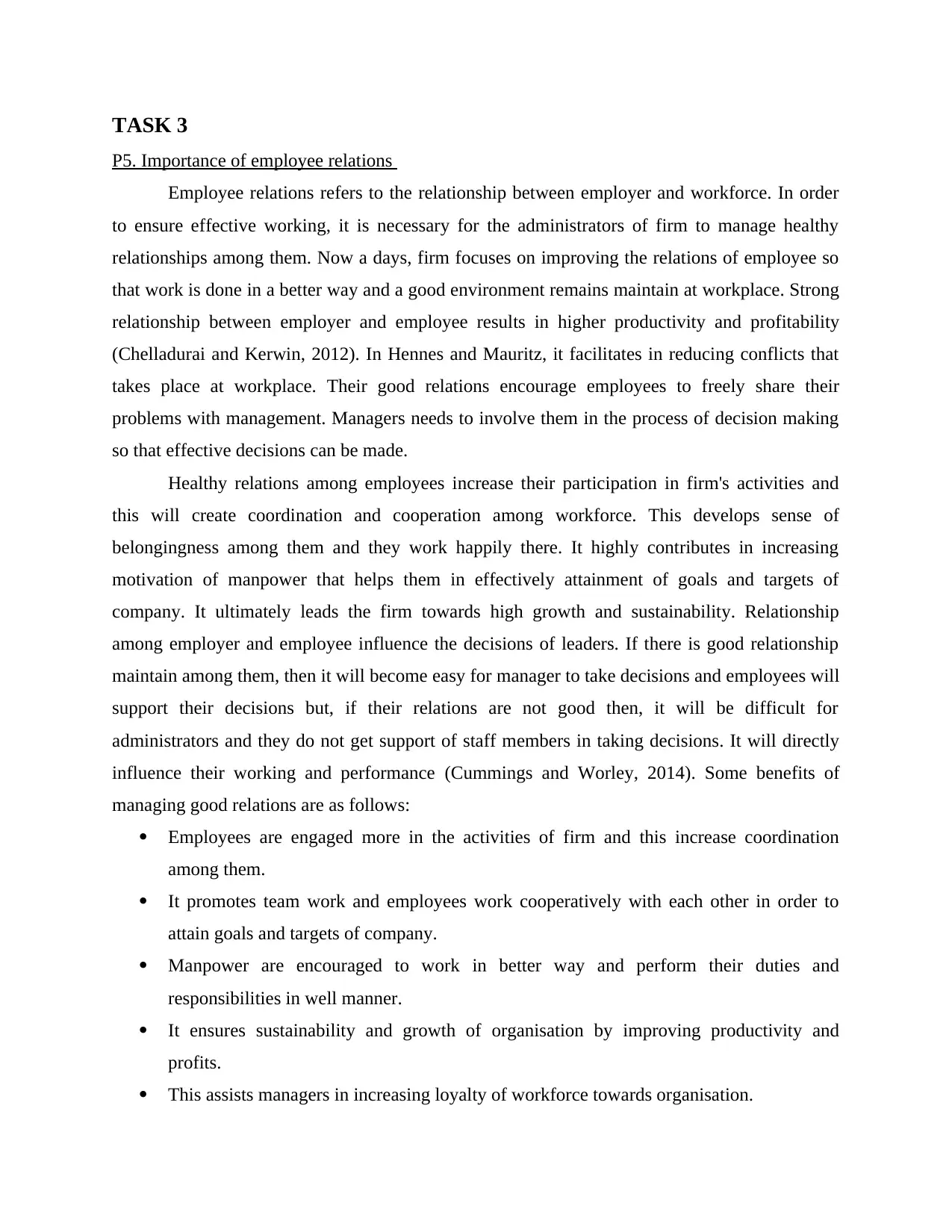
TASK 3
P5. Importance of employee relations
Employee relations refers to the relationship between employer and workforce. In order
to ensure effective working, it is necessary for the administrators of firm to manage healthy
relationships among them. Now a days, firm focuses on improving the relations of employee so
that work is done in a better way and a good environment remains maintain at workplace. Strong
relationship between employer and employee results in higher productivity and profitability
(Chelladurai and Kerwin, 2012). In Hennes and Mauritz, it facilitates in reducing conflicts that
takes place at workplace. Their good relations encourage employees to freely share their
problems with management. Managers needs to involve them in the process of decision making
so that effective decisions can be made.
Healthy relations among employees increase their participation in firm's activities and
this will create coordination and cooperation among workforce. This develops sense of
belongingness among them and they work happily there. It highly contributes in increasing
motivation of manpower that helps them in effectively attainment of goals and targets of
company. It ultimately leads the firm towards high growth and sustainability. Relationship
among employer and employee influence the decisions of leaders. If there is good relationship
maintain among them, then it will become easy for manager to take decisions and employees will
support their decisions but, if their relations are not good then, it will be difficult for
administrators and they do not get support of staff members in taking decisions. It will directly
influence their working and performance (Cummings and Worley, 2014). Some benefits of
managing good relations are as follows:
Employees are engaged more in the activities of firm and this increase coordination
among them.
It promotes team work and employees work cooperatively with each other in order to
attain goals and targets of company.
Manpower are encouraged to work in better way and perform their duties and
responsibilities in well manner.
It ensures sustainability and growth of organisation by improving productivity and
profits.
This assists managers in increasing loyalty of workforce towards organisation.
P5. Importance of employee relations
Employee relations refers to the relationship between employer and workforce. In order
to ensure effective working, it is necessary for the administrators of firm to manage healthy
relationships among them. Now a days, firm focuses on improving the relations of employee so
that work is done in a better way and a good environment remains maintain at workplace. Strong
relationship between employer and employee results in higher productivity and profitability
(Chelladurai and Kerwin, 2012). In Hennes and Mauritz, it facilitates in reducing conflicts that
takes place at workplace. Their good relations encourage employees to freely share their
problems with management. Managers needs to involve them in the process of decision making
so that effective decisions can be made.
Healthy relations among employees increase their participation in firm's activities and
this will create coordination and cooperation among workforce. This develops sense of
belongingness among them and they work happily there. It highly contributes in increasing
motivation of manpower that helps them in effectively attainment of goals and targets of
company. It ultimately leads the firm towards high growth and sustainability. Relationship
among employer and employee influence the decisions of leaders. If there is good relationship
maintain among them, then it will become easy for manager to take decisions and employees will
support their decisions but, if their relations are not good then, it will be difficult for
administrators and they do not get support of staff members in taking decisions. It will directly
influence their working and performance (Cummings and Worley, 2014). Some benefits of
managing good relations are as follows:
Employees are engaged more in the activities of firm and this increase coordination
among them.
It promotes team work and employees work cooperatively with each other in order to
attain goals and targets of company.
Manpower are encouraged to work in better way and perform their duties and
responsibilities in well manner.
It ensures sustainability and growth of organisation by improving productivity and
profits.
This assists managers in increasing loyalty of workforce towards organisation.
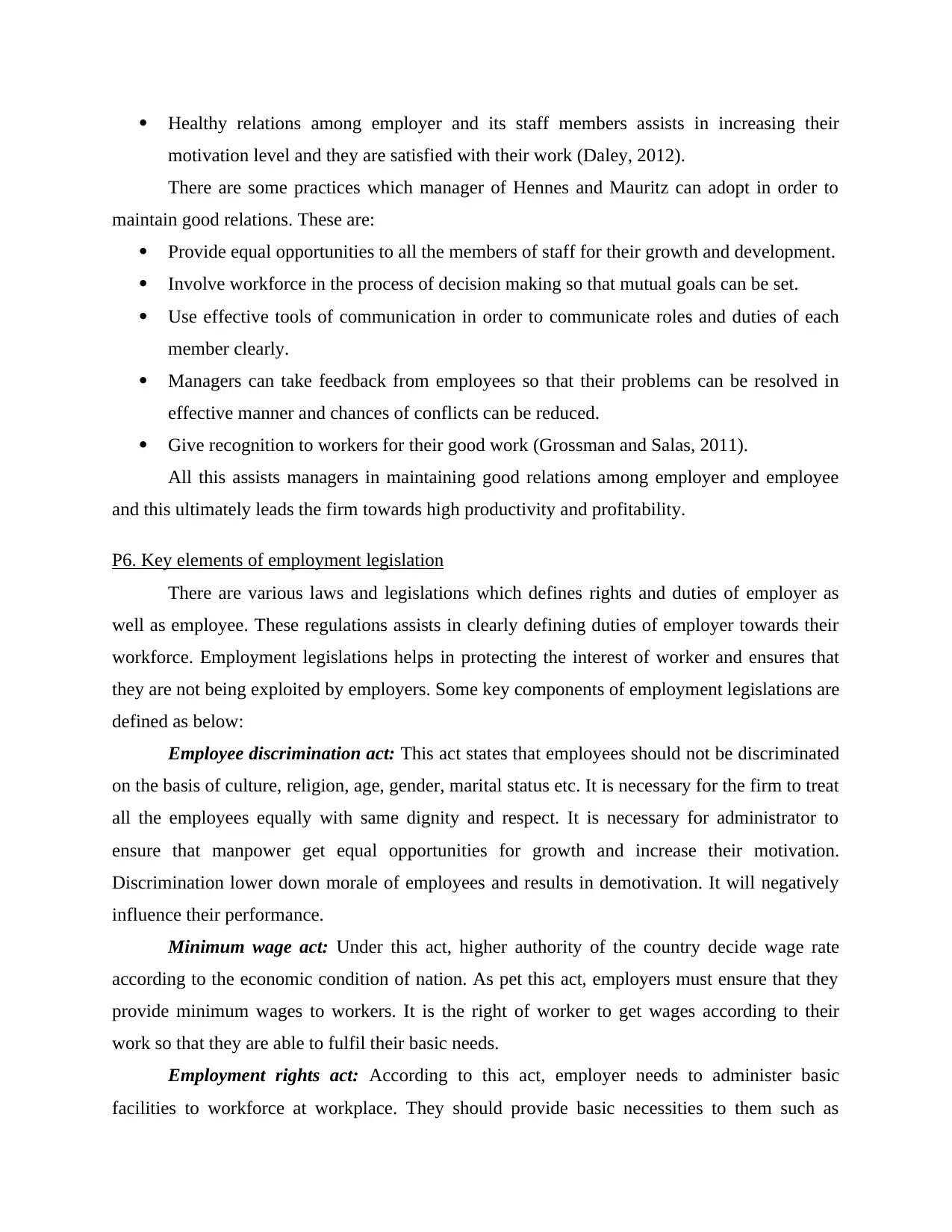
Healthy relations among employer and its staff members assists in increasing their
motivation level and they are satisfied with their work (Daley, 2012).
There are some practices which manager of Hennes and Mauritz can adopt in order to
maintain good relations. These are:
Provide equal opportunities to all the members of staff for their growth and development.
Involve workforce in the process of decision making so that mutual goals can be set.
Use effective tools of communication in order to communicate roles and duties of each
member clearly.
Managers can take feedback from employees so that their problems can be resolved in
effective manner and chances of conflicts can be reduced.
Give recognition to workers for their good work (Grossman and Salas, 2011).
All this assists managers in maintaining good relations among employer and employee
and this ultimately leads the firm towards high productivity and profitability.
P6. Key elements of employment legislation
There are various laws and legislations which defines rights and duties of employer as
well as employee. These regulations assists in clearly defining duties of employer towards their
workforce. Employment legislations helps in protecting the interest of worker and ensures that
they are not being exploited by employers. Some key components of employment legislations are
defined as below:
Employee discrimination act: This act states that employees should not be discriminated
on the basis of culture, religion, age, gender, marital status etc. It is necessary for the firm to treat
all the employees equally with same dignity and respect. It is necessary for administrator to
ensure that manpower get equal opportunities for growth and increase their motivation.
Discrimination lower down morale of employees and results in demotivation. It will negatively
influence their performance.
Minimum wage act: Under this act, higher authority of the country decide wage rate
according to the economic condition of nation. As pet this act, employers must ensure that they
provide minimum wages to workers. It is the right of worker to get wages according to their
work so that they are able to fulfil their basic needs.
Employment rights act: According to this act, employer needs to administer basic
facilities to workforce at workplace. They should provide basic necessities to them such as
motivation level and they are satisfied with their work (Daley, 2012).
There are some practices which manager of Hennes and Mauritz can adopt in order to
maintain good relations. These are:
Provide equal opportunities to all the members of staff for their growth and development.
Involve workforce in the process of decision making so that mutual goals can be set.
Use effective tools of communication in order to communicate roles and duties of each
member clearly.
Managers can take feedback from employees so that their problems can be resolved in
effective manner and chances of conflicts can be reduced.
Give recognition to workers for their good work (Grossman and Salas, 2011).
All this assists managers in maintaining good relations among employer and employee
and this ultimately leads the firm towards high productivity and profitability.
P6. Key elements of employment legislation
There are various laws and legislations which defines rights and duties of employer as
well as employee. These regulations assists in clearly defining duties of employer towards their
workforce. Employment legislations helps in protecting the interest of worker and ensures that
they are not being exploited by employers. Some key components of employment legislations are
defined as below:
Employee discrimination act: This act states that employees should not be discriminated
on the basis of culture, religion, age, gender, marital status etc. It is necessary for the firm to treat
all the employees equally with same dignity and respect. It is necessary for administrator to
ensure that manpower get equal opportunities for growth and increase their motivation.
Discrimination lower down morale of employees and results in demotivation. It will negatively
influence their performance.
Minimum wage act: Under this act, higher authority of the country decide wage rate
according to the economic condition of nation. As pet this act, employers must ensure that they
provide minimum wages to workers. It is the right of worker to get wages according to their
work so that they are able to fulfil their basic needs.
Employment rights act: According to this act, employer needs to administer basic
facilities to workforce at workplace. They should provide basic necessities to them such as
⊘ This is a preview!⊘
Do you want full access?
Subscribe today to unlock all pages.

Trusted by 1+ million students worldwide
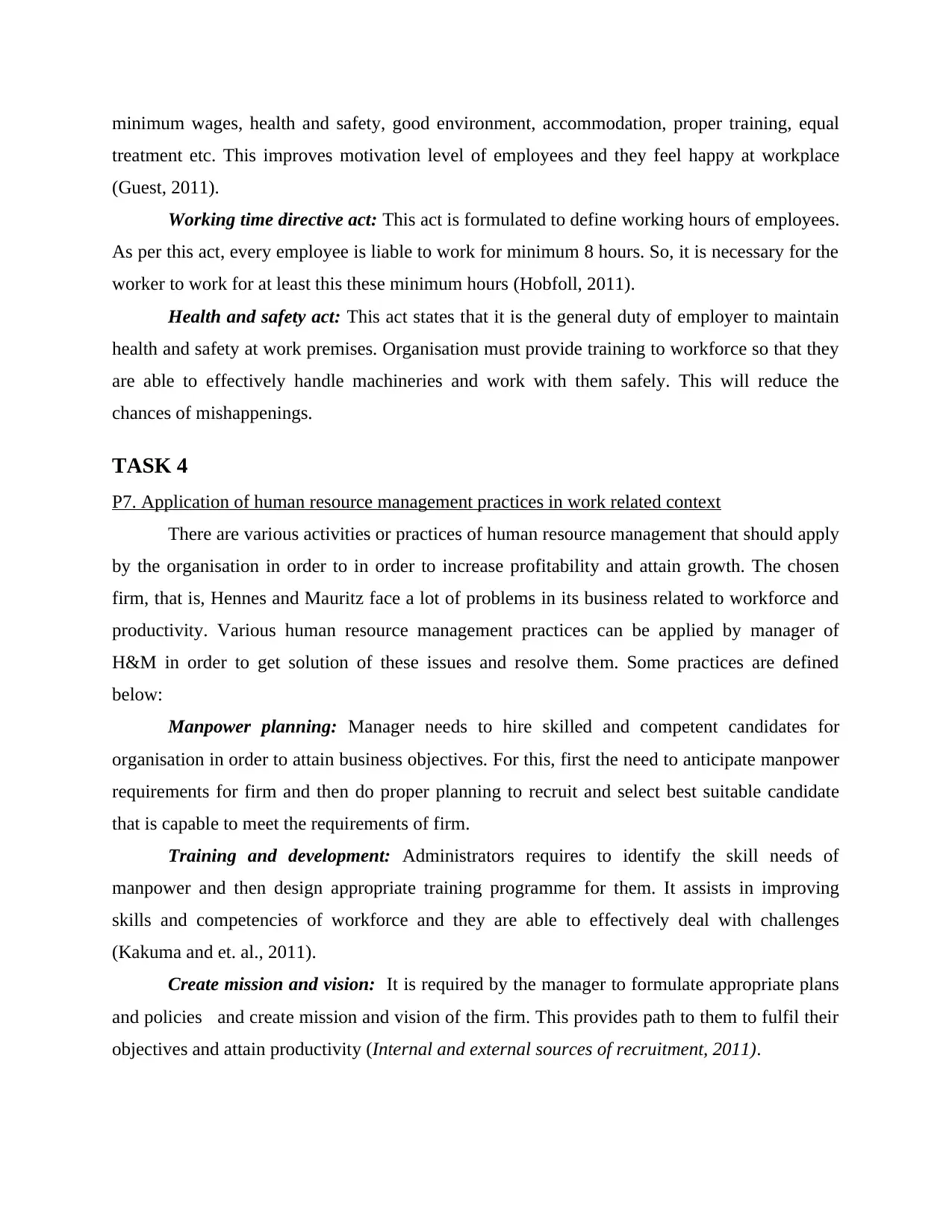
minimum wages, health and safety, good environment, accommodation, proper training, equal
treatment etc. This improves motivation level of employees and they feel happy at workplace
(Guest, 2011).
Working time directive act: This act is formulated to define working hours of employees.
As per this act, every employee is liable to work for minimum 8 hours. So, it is necessary for the
worker to work for at least this these minimum hours (Hobfoll, 2011).
Health and safety act: This act states that it is the general duty of employer to maintain
health and safety at work premises. Organisation must provide training to workforce so that they
are able to effectively handle machineries and work with them safely. This will reduce the
chances of mishappenings.
TASK 4
P7. Application of human resource management practices in work related context
There are various activities or practices of human resource management that should apply
by the organisation in order to in order to increase profitability and attain growth. The chosen
firm, that is, Hennes and Mauritz face a lot of problems in its business related to workforce and
productivity. Various human resource management practices can be applied by manager of
H&M in order to get solution of these issues and resolve them. Some practices are defined
below:
Manpower planning: Manager needs to hire skilled and competent candidates for
organisation in order to attain business objectives. For this, first the need to anticipate manpower
requirements for firm and then do proper planning to recruit and select best suitable candidate
that is capable to meet the requirements of firm.
Training and development: Administrators requires to identify the skill needs of
manpower and then design appropriate training programme for them. It assists in improving
skills and competencies of workforce and they are able to effectively deal with challenges
(Kakuma and et. al., 2011).
Create mission and vision: It is required by the manager to formulate appropriate plans
and policies and create mission and vision of the firm. This provides path to them to fulfil their
objectives and attain productivity (Internal and external sources of recruitment, 2011).
treatment etc. This improves motivation level of employees and they feel happy at workplace
(Guest, 2011).
Working time directive act: This act is formulated to define working hours of employees.
As per this act, every employee is liable to work for minimum 8 hours. So, it is necessary for the
worker to work for at least this these minimum hours (Hobfoll, 2011).
Health and safety act: This act states that it is the general duty of employer to maintain
health and safety at work premises. Organisation must provide training to workforce so that they
are able to effectively handle machineries and work with them safely. This will reduce the
chances of mishappenings.
TASK 4
P7. Application of human resource management practices in work related context
There are various activities or practices of human resource management that should apply
by the organisation in order to in order to increase profitability and attain growth. The chosen
firm, that is, Hennes and Mauritz face a lot of problems in its business related to workforce and
productivity. Various human resource management practices can be applied by manager of
H&M in order to get solution of these issues and resolve them. Some practices are defined
below:
Manpower planning: Manager needs to hire skilled and competent candidates for
organisation in order to attain business objectives. For this, first the need to anticipate manpower
requirements for firm and then do proper planning to recruit and select best suitable candidate
that is capable to meet the requirements of firm.
Training and development: Administrators requires to identify the skill needs of
manpower and then design appropriate training programme for them. It assists in improving
skills and competencies of workforce and they are able to effectively deal with challenges
(Kakuma and et. al., 2011).
Create mission and vision: It is required by the manager to formulate appropriate plans
and policies and create mission and vision of the firm. This provides path to them to fulfil their
objectives and attain productivity (Internal and external sources of recruitment, 2011).
Paraphrase This Document
Need a fresh take? Get an instant paraphrase of this document with our AI Paraphraser
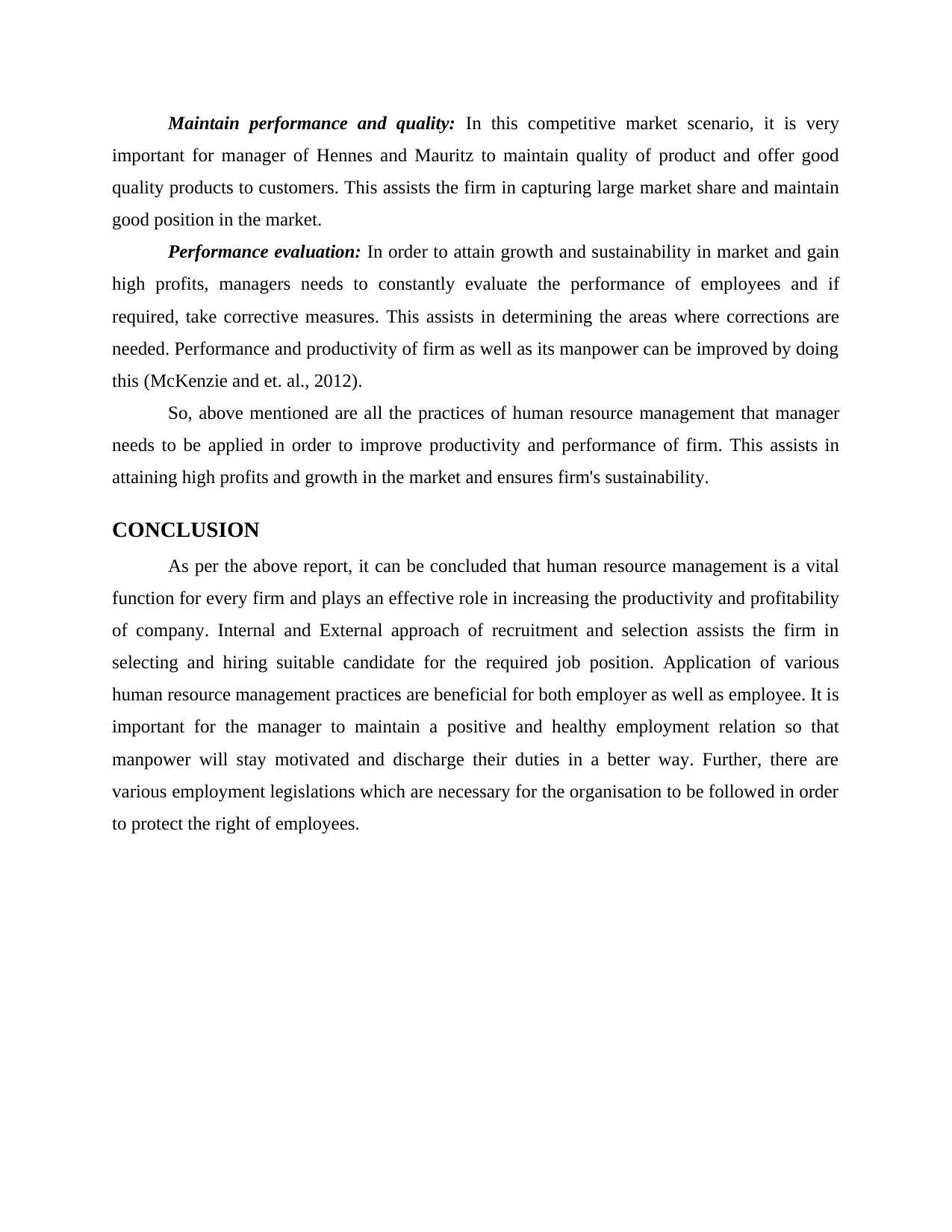
Maintain performance and quality: In this competitive market scenario, it is very
important for manager of Hennes and Mauritz to maintain quality of product and offer good
quality products to customers. This assists the firm in capturing large market share and maintain
good position in the market.
Performance evaluation: In order to attain growth and sustainability in market and gain
high profits, managers needs to constantly evaluate the performance of employees and if
required, take corrective measures. This assists in determining the areas where corrections are
needed. Performance and productivity of firm as well as its manpower can be improved by doing
this (McKenzie and et. al., 2012).
So, above mentioned are all the practices of human resource management that manager
needs to be applied in order to improve productivity and performance of firm. This assists in
attaining high profits and growth in the market and ensures firm's sustainability.
CONCLUSION
As per the above report, it can be concluded that human resource management is a vital
function for every firm and plays an effective role in increasing the productivity and profitability
of company. Internal and External approach of recruitment and selection assists the firm in
selecting and hiring suitable candidate for the required job position. Application of various
human resource management practices are beneficial for both employer as well as employee. It is
important for the manager to maintain a positive and healthy employment relation so that
manpower will stay motivated and discharge their duties in a better way. Further, there are
various employment legislations which are necessary for the organisation to be followed in order
to protect the right of employees.
important for manager of Hennes and Mauritz to maintain quality of product and offer good
quality products to customers. This assists the firm in capturing large market share and maintain
good position in the market.
Performance evaluation: In order to attain growth and sustainability in market and gain
high profits, managers needs to constantly evaluate the performance of employees and if
required, take corrective measures. This assists in determining the areas where corrections are
needed. Performance and productivity of firm as well as its manpower can be improved by doing
this (McKenzie and et. al., 2012).
So, above mentioned are all the practices of human resource management that manager
needs to be applied in order to improve productivity and performance of firm. This assists in
attaining high profits and growth in the market and ensures firm's sustainability.
CONCLUSION
As per the above report, it can be concluded that human resource management is a vital
function for every firm and plays an effective role in increasing the productivity and profitability
of company. Internal and External approach of recruitment and selection assists the firm in
selecting and hiring suitable candidate for the required job position. Application of various
human resource management practices are beneficial for both employer as well as employee. It is
important for the manager to maintain a positive and healthy employment relation so that
manpower will stay motivated and discharge their duties in a better way. Further, there are
various employment legislations which are necessary for the organisation to be followed in order
to protect the right of employees.

REFERENCES
Books and Journals
Anderson, V., 2013. Research methods in human resource management: investigating a business
issue. Kogan Page Publishers.
Aswathappa, K., 2013. Human resource management: Text and cases. Tata McGraw-Hill
Education.
Bamberger, P. A., Biron, M. and Meshoulam, I., 2014. Human resource strategy: Formulation,
implementation, and impact. Routledge.
Brewster, C. and Hegewisch, A. eds., 2017. Policy and Practice in European Human Resource
Management: The Price Waterhouse Cranfield Survey. Taylor & Francis.
Cummings, T. G. and Worley, C. G., 2014. Organization development and change. Cengage
learning.
Daley, D. M., 2012. Strategic human resources management. Public Personnel Management,
pp.120-125.
Grossman, R. and Salas, E., 2011. The transfer of training: what really matters. International
Journal of Training and Development. 15(2). pp.103-120.
Guest, D. E., 2011. Human resource management and performance: still searching for some
answers. Human resource management journal. 21(1). pp.3-13.
Hobfoll, S. E., 2011. Conservation of resource caravans and engaged settings. Journal of
occupational and organizational psychology. 84(1). pp.116-122.
Kakuma, R. and et. al., 2011. Human resources for mental health care: current situation and
strategies for action. The Lancet. 378(9803). pp.1654-1663.
Meredith Belbin, R., 2011. Management teams: Why they succeed or fail. Human Resource
Management International Digest. 19(3).
Payne, V. G. and Isaacs, L. D., 2017. Human motor development: A lifespan approach.
Routledge.
Romney, M. B. and Steinbart, P. J., 2012. Accounting information systems. Boston: Pearson.
Unger, J. M. and et. al., 2011. Human capital and entrepreneurial success: A meta-analytical
review. Journal of business venturing. 26(3). pp.341-358.
Werner, J. M. and DeSimone, R. L., 2011. Human resource development. Cengage Learning.
Online
Books and Journals
Anderson, V., 2013. Research methods in human resource management: investigating a business
issue. Kogan Page Publishers.
Aswathappa, K., 2013. Human resource management: Text and cases. Tata McGraw-Hill
Education.
Bamberger, P. A., Biron, M. and Meshoulam, I., 2014. Human resource strategy: Formulation,
implementation, and impact. Routledge.
Brewster, C. and Hegewisch, A. eds., 2017. Policy and Practice in European Human Resource
Management: The Price Waterhouse Cranfield Survey. Taylor & Francis.
Cummings, T. G. and Worley, C. G., 2014. Organization development and change. Cengage
learning.
Daley, D. M., 2012. Strategic human resources management. Public Personnel Management,
pp.120-125.
Grossman, R. and Salas, E., 2011. The transfer of training: what really matters. International
Journal of Training and Development. 15(2). pp.103-120.
Guest, D. E., 2011. Human resource management and performance: still searching for some
answers. Human resource management journal. 21(1). pp.3-13.
Hobfoll, S. E., 2011. Conservation of resource caravans and engaged settings. Journal of
occupational and organizational psychology. 84(1). pp.116-122.
Kakuma, R. and et. al., 2011. Human resources for mental health care: current situation and
strategies for action. The Lancet. 378(9803). pp.1654-1663.
Meredith Belbin, R., 2011. Management teams: Why they succeed or fail. Human Resource
Management International Digest. 19(3).
Payne, V. G. and Isaacs, L. D., 2017. Human motor development: A lifespan approach.
Routledge.
Romney, M. B. and Steinbart, P. J., 2012. Accounting information systems. Boston: Pearson.
Unger, J. M. and et. al., 2011. Human capital and entrepreneurial success: A meta-analytical
review. Journal of business venturing. 26(3). pp.341-358.
Werner, J. M. and DeSimone, R. L., 2011. Human resource development. Cengage Learning.
Online
⊘ This is a preview!⊘
Do you want full access?
Subscribe today to unlock all pages.

Trusted by 1+ million students worldwide
1 out of 13
Related Documents
Your All-in-One AI-Powered Toolkit for Academic Success.
+13062052269
info@desklib.com
Available 24*7 on WhatsApp / Email
![[object Object]](/_next/static/media/star-bottom.7253800d.svg)
Unlock your academic potential
Copyright © 2020–2025 A2Z Services. All Rights Reserved. Developed and managed by ZUCOL.





